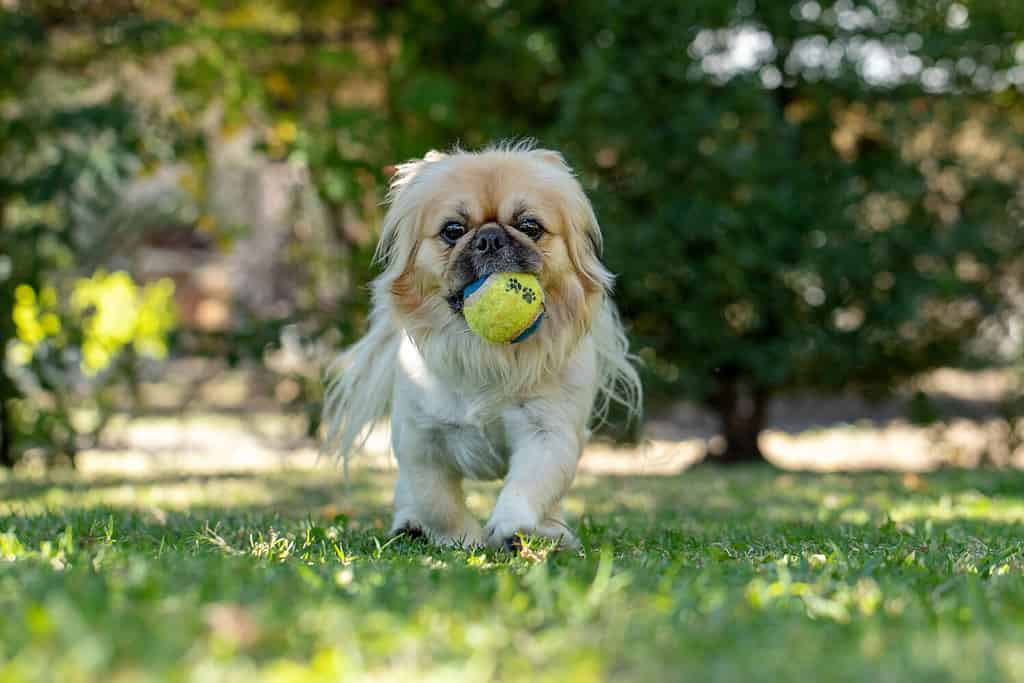Pekingese are often advertised as being rather healthy. They indeed have a rather long lifespan of 12 – 15 years. However, there are tons of common Pekingese health problems. Most of these dogs will end up with some sort of serious health issue before their later years.
Here’s a list of the most common health problems these dogs face,
1. Brachycephalic

These canines should only be exercised moderately, as they often have a hard time breathing.
©AJ Laing/Shutterstock.com
Practically all Pekingese are brachycephalic to some degree. This condition occurs when a dog’s snout is shortened. Because of their squished airway, their respiratory system is a bit dysfunctional. They cannot breathe as easily as other dog breeds, leading to all sorts of health issues.
It isn’t odd for these dogs to snort and become winded with light exertion. They’re prone to exercise-induced exhaustion, as they cannot breathe in as much oxygen as other dogs. It’s best not to overdo the exercise.
They also cannot pant properly, leading to heat stroke and similar issues. They do best when kept in an air-conditioned space anytime it is warm. Don’t let them run around or exercise in hot weather.
2. Dental Disease
Their shortened snout also means that their teeth are crowded. This causes all their teeth to push together, allowing bacteria to set up between teeth more easily. In the end, this leads to more dental issues.
While minor dental issues aren’t a huge issue when treated, they can lead to serious problems. Infected gums provide an easy access point for bacteria into the body, potentially leading to heart disease and other issues. It isn’t odd for dogs to die of untreated dental problems.
Teeth brushing and regular dental cleanings can help. Your vet may also recommend removing some of your dog’s teeth to prevent crowding.
3. Intervertebral Disk Disease

Due to their very long back, these dogs are prone to back issues.
©GlobalP/iStock via Getty Images
Pekingese have short legs and long backs. This leads to their spine not being properly supported and more prone to injury. One of these injuries is intervertebral disk disease, which is caused by running, jumping, and other simple activities. It can cause pain, lameness, and paralysis.
IVDD can be treated, but treatments can be expensive and don’t always work. Sometimes, simple crate rest is all that’s needed to turn a dog around. Other times, even surgery may not prevent permanent paralysis.
Dogs that develop IVDD once are much more prone to developing it again. You should take care to use ramps and doggie steps against beds and couches. Simply letting your dog jump can increase their chance of injury.
4. Eye Problems
A Pekingese’s eyes sit out further than in more practical dog breeds. This physical feature increases the chance of their eyes becoming injured. Sadly, corneal ulcers, dry eye, and cherry eye are all common conditions in this breed.
There are a surprising number of bling Pekingese, as well. They tend to develop cataracts and progressive retinal atrophy. While surgery can solve cataracts, PRA is genetic and not curable. It always leads to blindness.
5. Hip Dysplasia

Sadly, these dogs were built mostly for appearance, which has led to many of their features being dramatized.
©swapan_banik/iStock via Getty Images
To go along with their other skeletal problems, Pekingese are also prone to hip dysplasia. This condition is most common in larger dogs, but Pekes are surprisingly very prone to it, too. About 32% of Pekes will end up with hip dysplasia.
Luckily, because these dogs are small, hip dysplasia does not cause the same severity of symptoms that it may cause for older dogs. Many Pekingese do not show signs of the illness at all. However, it almost always causes arthritis as the dog reaches their senior years. Because these dogs live for so long, they’ll often live with arthritis for much of their lifespan.
6. Ear Infections
Because Pekes have hair inside their ear canal, they are somewhat prone to ear infections. However, these typically only occur if the fur in their ears is left untrimmed. It’s important to keep it cut down. Too much fur can trap debris and moisture, leading to infections.
Proper cleaning can also help prevent ear infections, too. If your dog is prone to ear infections, your vet may recommend a regular cleaning solution to help remove bacteria and grime before an infection can occur.
7. Luxating Patella

Most of the health problems faced by these dogs are related to their shortened snout or often malformed skeletal system.
©DevidDO/iStock via Getty Images
“Loose kneecaps” are pretty common amongst smaller dogs, and Pekingese are no different. This condition occurs when the kneecap moves out of position a bit too much, causing excessive wear. Over time, this condition can cause arthritis to occur. Luckily, there are surgeries available to fix the structural defect, though these can cost quite a bit of money.
Plus, surgeries can be a bit riskier for Pekingese than other dogs because they’re brachycephalic. Anesthesia often causes depressed breathing, and these dogs have trouble breathing, anyway.
The photo featured at the top of this post is © SheltieBoy, CC BY 2.0
Ready to discover the top 10 cutest dog breeds in the entire world?
How about the fastest dogs, the largest dogs and those that are -- quite frankly -- just the kindest dogs on the planet? Each day, AZ Animals sends out lists just like this to our thousands of email subscribers. And the best part? It's FREE. Join today by entering your email below.
Thank you for reading! Have some feedback for us? Contact the AZ Animals editorial team.






